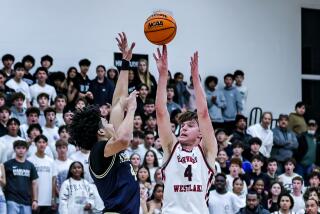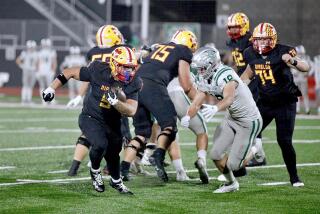Exclusion Rule Draws Fire From Lower Divisions : Athletes Are Restricted to Finals at Own NCAA Level
- Share via
Jeff Kubiak of Cal State Northridge is a five-time NCAA swim champion. At last year’s Division II national championships he won three individual events and was selected by coaches as the meet’s outstanding swimmer.
There is not much more for Kubiak to accomplish in Division II in this his senior season, but the prospect of competing against the nation’s best at the Division I meet has driven him to train harder than ever.
Swimmers who finish first or second at the Division II championships can compete in the Division I meet provided their times meet certain qualifying standards. And for Kubiak, those standards won’t be a problem. He has the third-best time nationally in the 200 breast (2:01.1) this season.
Future Division II swimmers--even those as good or better than Kubiak--will not have the same opportunity, however.
The NCAA Executive Committee last year abolished the rule enabling top Division II and Division III athletes to compete at Division I championships. A proposal to rescind the Committee’s decision failed in a combined vote of delegates from all three divisions at last week’s NCAA Convention in San Diego.
As a result, athletes from lower-division swimming, cross country, golf, gymnastics, tennis, track and wrestling programs who enroll after Aug. 1 will not be eligible to compete for Division I titles.
The proposal failed by a large margin and without a floor count. The almost 300 Division I delegates voted near unanimously against the measure; delegates from divisions II and III were split.
Floor speakers opposed to the measure concentrated on three areas of attack.
That lower-division athletes already had opportunities to win championships at their own levels and shouldn’t be allowed to compete for more than one.
That Division I team standings were being influenced by athletes from other divisions placing high enough to score points.
That athletes from lower divisions had made a choice as to what level they would compete at when they enrolled in college.
Proponents of the initiative, such as Stan Clark, chairman of the Department of Kinesiology and Physical Education at Cal State Hayward, contend athletes from divisions II and III should have the opportunity to advance as far as their talent takes them.
“I would hope that people made the decision on where to go to college based on their educational needs,” Clark said in a telephone interview Thursday. “If that’s at a Division II or III institution then they should go there without having to worry about the advantages of Division I or II athletics.
“When they talk about education being the prime concern for our student-athletes and then put in legislation like this, they’re talking out of both sides of their mouth.”
Clark, formerly the tennis coach at Hayward, cited tennis players Ken Flach and Robert Seguso as an example of lower-division athletes who used the Division I championships as a springboard for their careers.
Flach and Seguso won the Division II doubles championship for Southern Illinois-Edwardsville, then won the Division I title a few weeks later. They went on to win the U.S. Open doubles championship and have represented the United States in Davis Cup competition the past three years.
“The question ‘Why should these kids have the opportunity to compete in Division I?’ is rather ridiculous,” Clark said. “In tennis, Division I players get a chance to play in tournaments like Nike, Rolex and the National Indoor Championships. Those players get opportunities division II and III players only dream about.”
Northridge has been able to place several athletes at Division I championships.
Sue Patterson finished in the top 10 in the high jump at the track and field championships last year. Shawn Denton (1984) and Paul Kulak (1983) of CSUN finished in the top six in the Division I javelin throw.
Allowing lower-division athletes to compete in Division I championships gave a person who did not possess enough ability as a high school senior the incentive to compete at the higher level, said Don Strametz, Northridge track and field coach.
Three Northridge swimmers met Division I qualifying standards last year--Kubiak in the 200 breast and two sophomores, Stacy Mettam in the 100 backstroke and Tina Schnare in the 100 and 200 breaststroke. Although none of them chose to compete, Coach Pete Accardy said all three will swim in the Division I meet this year if they qualify. Kubiak already has.
“You are supposed to be able to swim against the best and this rule doesn’t allow you to do that,” Accardy said. “Are they afraid some Division II kid might be as good or better than the best in Division I? Would that embarrass them?
“If I was the best Division I swimmer and some guy in Division II had a better time in my event, I would want the opportunity to prove I could beat him rather than back into a championship. It doesn’t happen often, but it might.”
Clark said another proposal to reinstate the rule probably will be brought before the convention for a vote next year.
More to Read
Go beyond the scoreboard
Get the latest on L.A.'s teams in the daily Sports Report newsletter.
You may occasionally receive promotional content from the Los Angeles Times.











